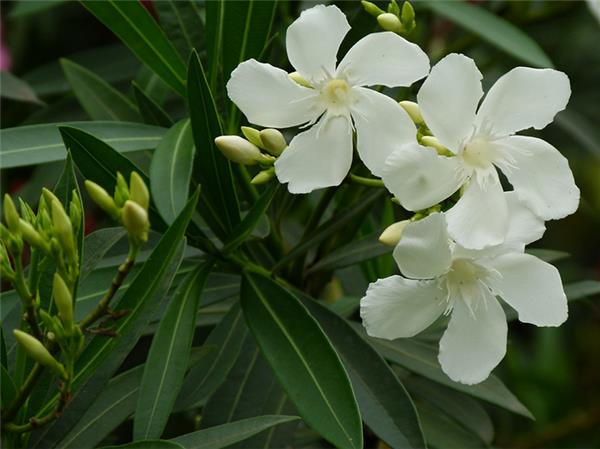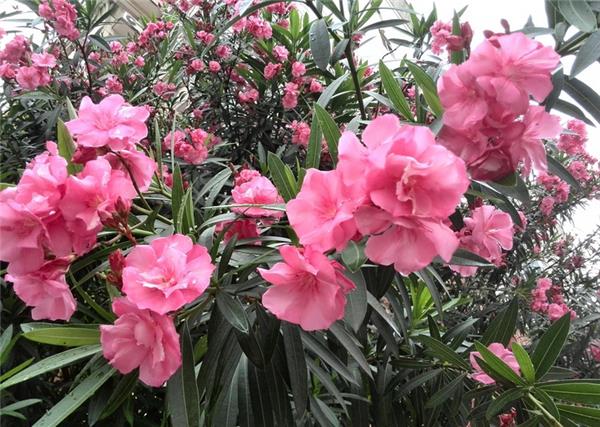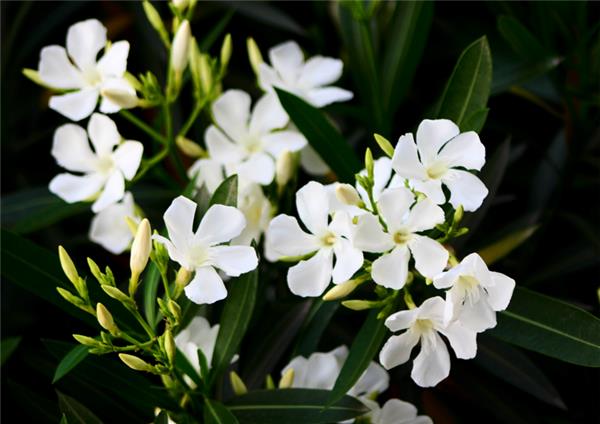Culture methods and matters needing attention of oleander
Oleander leaves such as willow bamboo, red flowers burning, better than peach blossoms, is a famous ornamental flower. How to raise oleander? Next, let's take a look at the culture methods and points for attention of oleander.

Culture methods of oleander
I. overturn
Potted oleander needs to turn the pot and change the soil once a year, and a little feather hoof horn can be put at the bottom of the basin. During the growth period, liquid fertilizer can be applied 1 or 2 times according to the growth. Oleander is resistant to pruning and has strong germinating ability. senescent plants can be renewed and pruned in spring combined with turning pots and changing soil to cut off all branches from the base to promote their germination and rejuvenation. In general, the plant should also be moderately pruned in spring to keep the plant well-balanced and strong.
2. Pruning
Through pruning, the branches are evenly distributed, the flowers are colourful and the tree shape is beautiful. The top branch of oleander has the characteristic of one-third, which can be trimmed and shaped according to the need. If you need a trigeminal nine-top shape, you can cut off a part of it at the top of the tripod and you can divide it into nine. If you need nine top eighteen branches, you can leave six branches, cut off from the axils of the top leaves, and eighteen branches can be produced. The pruning time should be after each flowering. In the north, oleander florescence is from April to October. The blooming flowers should be got in time to ensure the concentration of nutrients. It is generally divided into four pruning times: first, after Grain Rain in spring; second, in July and August; third, in October, and fourth, in winter. If you want to blossom indoors, move it to the sunshine of about 15 ℃. Prune immediately after flowering, otherwise, the flowers are few and small, or even do not bloom.

Third, thinning the roots
The capillary root of oleander grows faster. The three-year-old oleander, planted in a basin with a diameter of 20 centimeters, can grow full of roots before July of that year, forming a ball, hindering the infiltration of water and fertilizer and affecting growth. If the roots are not thinned in time, there will be withering, fallen leaves, death and so on. The best time for root thinning is from early August to late September. At this time, the root is dormant, which is a good opportunity to soothe the root. Root thinning method: use a fast shovel to cut off the surrounding yellow hair root, and then use a tricuspid hook to sparse along the main root. About half or 1/3 of the yellow hairy roots are removed and replanted in the pot. After thinning the roots, pour water in the shade to keep the basin soil moist. Keep shade for about 14 days, then move to the sun. If oleander is planted in the ground, the yellow hairy root should also be cut around the main pole in mid-September. After cutting the roots, water them and apply thin liquid fertilizer.
4. Topdressing
Oleander is a flower that likes fertilizer and water, neutral or slightly acidic soil. Fertilization should keep organic soil manure accounting for about 20% of the basin soil. If it is used in chicken manure, 15% is enough. Fertilization time: one time before Qingming Festival and one time after the Autumn Equinox. Methods: digging annular trenches at the edge of the basin, applying fertilizer and then covering the soil. After Qingming fertilization, bean cake water retted with water was applied every 10 days or so; after the Autumn Equinox applied fertilizer, bean cake water or peanut cake water, or ten times the amount of chicken manure, was applied every 10 days or so. Without the above fertilizer, you can add five to seven times the water in the urine of people who have been mature for more than seven days, pour it along the edge of the basin, and then pour water thoroughly. Fertilizer with more nitrogen, the principle is dilute, light, less, diligent, strictly prevent burning roots.

Fifth, watering
Proper watering is the key to the management of oleander. Improper watering in winter and summer will cause fallen leaves, flowers, and even death. It is watered once a day in spring and once in the morning and evening in summer, so that the moisture of the basin soil can be kept at about 50%. The leaves should be sprayed with water frequently. If it is too dry, it is easy to lose leaves and wither. Watering can be reduced in winter, but the soil moisture in the basin should be kept at about 40%. The leaves should often be washed with clean water to wash the dust. If it blossoms in winter, it can keep the room temperature above 15 ℃; if it does not blossom in winter, the room temperature can be reduced to 7: 9 ℃, which can be placed in the room where there is no sunlight. Oleander planted outdoors in the north needs to be bandaged with herbs to prevent freezing and cold, and remove the cold protection before and after the Qingming Festival. Although oleander is easy to manage, it cannot be paralyzed.

Matters needing attention in oleander culture
Oleander likes plenty of light, warm and humid climate. It is also slightly hardy and can survive the winter in the warm temperate zone without falling leaves. Potted plants in summer should be watered and sprayed frequently to keep the potted soil and the environment moist, but must not be wet for a long time. Oleander also has a characteristic, as long as there is a drought dehydration or water logging, the lower leaves of the plant will soon turn yellow and fall off, so watering should be timely and appropriate. After strong pruning in early spring, you should pay attention to strangling water to prevent root infection and decay. Timely loose pot soil, timely removal of flowers after withering, occasional aphids and red spiders in summer, can be eliminated with general pesticides. The whole oleander plant is highly toxic, and the symptoms after poisoning are nausea, vomiting, lethargy, arrhythmia, and even loss of consciousness or death in serious cases, so in the face of oleander, just enjoy it, but don't do it!
To prevent root infection and decay. Timely loose pot soil, timely removal of flowers after withering, occasional aphids and red spiders in summer, can be eliminated with general pesticides. The whole oleander plant is highly toxic, and the symptoms after poisoning are nausea, vomiting, lethargy, arrhythmia, and even loss of consciousness or death in serious cases, so in the face of oleander, just enjoy it, but don't do it!
Related
- Wuhan Hospital Iron Tree Blooming Result Was Instantly Frightened by the Gardener Master
- Which variety of camellia is the most fragrant and best? Which one do you like best?
- What is the small blue coat, the breeding methods and matters needing attention of the succulent plant
- Dormancy time and maintenance management of succulent plants during dormancy
- Minas succulent how to raise, Minas succulent plant pictures
- What are the varieties of winter succulent plants
- How to raise succulent plants in twelve rolls? let's take a look at some experience of breeding twelve rolls.
- Attention should be paid to water control for succulent plants during dormant period (winter and summer)
- Watering experience of twelve rolls of succulent plants
- Techniques for fertilizing succulent plants. An article will let you know how to fertilize succulent plants.



